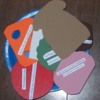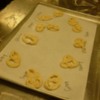The Lord's Prayer
Cooking Workshop
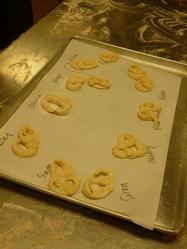
Summary of Lesson Activities:
Using Bread Stick dough, make "prayer pretzels" and write "sentence" prayers to be used in an upcoming worship service.
Scripture Reference:
Matthew 6:5-15, Luke 11:1-4
Key/Memory Verse: The Lord's Prayer
Lesson Objectives:
After completing this Rotation, participants will be able to:
- Name that the story is found in the New Testament. Identify the four Gospels.
- For 3rd grade and up: Locate the story.
- Define prayer as a means of growing a personal relationship with God: talking and listening to God – anytime, any place, and about anything.
- Retell the story in his/her own words of the disciples asking Jesus to teach them to pray, and Jesus’ response, known as the Lord’s Prayer.
- Describe the Lord’s Prayer as universal, spoken in languages around the world, uniting Christians in their faith.
- Discuss the meaning of portions of the Lord’s Prayer.
Leader Preparation:
- Read the scripture for this lesson.
- Read and reflect on the overview material provided for this lesson.
- Using modern translations of the Bible (such as The Message or The Voice) come up with a rap version of the Lord's Prayer. (Link to four "modern" versions of Matt 6:9-15).
For example: "Give us each day that day’s bread—no more, no less." - Practice your rap.
- Watch a short video about how to twist pretzels at http://shape-pretzel.notlong.com
- Gather the following materials:
- Easel; appropriate maker and sheet(s) of easel paper
- Sticky tack for hanging up sheet(s) of easel paper
- For 3rd grade and up: Bibles
- Aprons (optional)
- Packages of refrigerated breadsticks – allow two pretzels (2 breadsticks) per student
- Zipper sandwich bags (one per student)
- Copies of the Lord’s Prayer to hand-out
- Pencils or Pens (one per student) and paper (scratch paper is okay)
- In the kitchen: Large cookie sheets, Hot pads, Spatula, Parchment paper, Kosher salt, Flour, Cups, Napkins, Clean-up supplies
- Before the Start of Class:
- Write in large letters, the Lord’s Prayer on a piece(s) of easel paper and post it on the wall where it can be seen. Highlight the phrase: “Give us this day our daily bread."
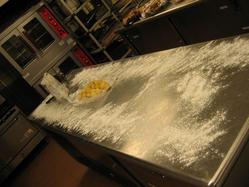 Pre-dusting work areas with flour is a good idea!Kids are ready to dive right in with the pretzel forming.
Pre-dusting work areas with flour is a good idea!Kids are ready to dive right in with the pretzel forming.- When 3rd grade and up will visit, distribute Bibles around the tables.
- Cover two large cookie sheets with parchment paper.
- Dust an appropriate number of work areas on the metal table(s) with flour. (See photo on the right).
- Preheat oven 375 degrees
Lesson Plan: Opening
Greet your students warmly, welcoming them to the Cooking Workshop. Introduce yourself and any other adults.
Say: This month we are learning about the Lord’s Prayer. Today we are going to be making a type of bread.
Ask: I am wondering how break ties into the Lord’s Prayer.
Say: That's right! The Lord's Prayer mentions bread: "Give us this day our daily bread." (Refer to the highlighted easel paper.) Today we are going to make a type of bread – we'll be making pretzels. I'm sure you'll be surprised to learn, pretzels have a tie to prayer! First, let’s start with prayer.
Ask for any prayer requests. [It is ok to write them down.] Ask if anyone would like to help lead the prayer or perhaps the Lord's Prayer at the end. A prayer suggestion: Holy Lord God, we are thankful to be here today gathered in your name, to learn and to experience your love for us. (Pray for requests.) Help us to be open to opportunities to work at becoming friends with you. (End with the Lord’s Prayer) Amen.
Dig in to the lesson:
Ask: Has anyone ever written down a prayer? (allow a few replies)
Say: In a little while, we’ll have a chance to write down or to dictate to an adult, what we call sentence prayers; prayers that are short and are only one sentence long.
Ask: Does anyone know who first wrote down the Lord’s Prayer?
Say: Jesus was the one who first spoke what we now call the Lord’s Prayer, but it was written down for us to read by some followers of Jesus named Matthew and Luke. Matthew and Luke wrote about a time when Jesus taught his disciples how to pray.
Ask: Do the names Matthew and Luke sound familiar to you? (allow a few replies)
Say: That’s right, those are the names of two of books of the Bible.
Ask: The books Matthew and Luke are part of a collection of four books. What do we call those four books? (the Gospels)
There are four Gospels; what are their names? (Matthew, Mark, Luke, & John)
What Testament of the Bible do we find the Gospels? (the New Testament)
For 3rd grade and up:
Do: Make sure that everyone has access to a Bible. Review the quick way to find the New Testament: Opening the Bible in middle lands you usually in Psalms. Taking just the back half and finding middle of that, gets you to beginning of the New Testament.
Have everyone find Luke 11:1. Ask a student to read verse one.
Ask: Whom do you suppose this man, “John” is? (John the Baptist)
I wonder why the disciples are asking Jesus to teach them to pray? (wait for an answer)Say: Perhaps they were confused about how to pray.
Ask: Have you ever wondered about how to pray? (allow a few replies)
Do: Have everyone find Matthew 6:5. (Review the order of the Gospels: Matthew, Mark. Luke and John.)
Say: Even though these are both stories about the Lord’s Prayer, Matthew and Luke tell the story differently. Some time this week sit down with your family and compare the two tellings of this story. In Luke, just before Jesus teaches the disciples how to pray, he had been talking about how not to pray.
Do: Have students follow along as you read the first portion of Matthew 6:5 – “And when you pray, do not be like the hypocrites, for they love to pray standing in the synagogues and on the street corners to be seen by men.”
Say: Jesus was talking about people who were praying just to show off; so that their friends would see them praying and think that they were close to God. That is not what Jesus teaches.
Do: Have students find Matthew 6:9 and read verses 9 - 11.
Ask: Do you recognize the Lord’s Prayer?
For all students:
Say: I'm going to say a version of the Lord's Prayer in a way you may not have heard before. When Jesus first taught the disciples how to pray, he didn’t use this method, but I’ll bet that Jesus would like this.
Do: Say the Lord's Prayer in rap.
Say: That was like a rap wasn’t it?
Do: Have students repeat the part about daily bread.
Say: Let’s make a type of daily bread – pretzels.
Ask: Does anyone know the story of how the pretzel was invented?
Say: Pretzels had their beginning about 1,400 years ago. At that time, during Lent, which is the time before Easter, Christians would give up eating milk and butter. So the type of bread they would eat during Lent was just made out of flour, water and salt. The story is that a monk (a religious person) was making this special bread for Lent and decided to shape the dough to represent someone praying. People often prayed at that time, with their arms folded across their chests, each hand on the opposite shoulder.
Place hands as described.
Ask: Do my arms look like a pretzel shape?
Say: It occurred to this monk that he could twist bread dough into this shape and use it as a treat for any children who learned to recite their prayers. Now whenever you eat a pretzel you can think about prayer! Let’s make some pretzels and talk more about prayer.
The Pretzel “recipe”
Have everyone wash their hands.
Open the packages of bread stick dough. Have kids help you separate the dough into 12 sticks per package.
Roll each individual stick of dough into a rope about 15 inches long. This can be done right on the metal tabletop in the floured areas.
When the first person has a rope ready, stop everyone and give a lesson in making a pretzel shape.
Say: Bring the ends of the rope up and cross them over each other twice. Pull the twisted ends down and seal tightly.
Ask: Does it look like arms folded in prayer?
Have everyone create two pretzels and place on parchment-covered baking sheets. Sprinkle lightly with Kosher Salt. Bake at 375 for 13-15 minutes.
Ask the Shepherd to time the pretzels. When they are done, allow them to cool for a few minutes on the cookie sheets and then bring them to the students.
Discussion while pretzels are baking:
Ask: So what is prayer? (accept all answers)
Say: Prayer is talking and listening to God. We can pray to God any time, any place and about everything.
Ask: Why do we talk to God? (accept a few answers)
Say: God would really like to be your best friend.
Ask: Have you recently met some new people, as school has just started?
How can these new people become your friends?
Say: We become friends with someone by talking to them, by getting to know them and by including them in our daily lives. It works the same way with God! Prayer helps you to include God in your life.
Ask: Does God want to hear us just chatter away about anything?(accept a few answers)
Say: We can pray to God about everything! God wants very much to hear what is on our minds, whether it is things we are worried about or things for which we are thankful. God loves to hear us talk to him either out loud, or silently in our heads. We can talk to God any time and any place.
Ask: Part of the Lord’s Prayer says: Give us this day our daily bread. What do you suppose that means?
Why “bread” and not something else - why not give us this day our daily cheeseburger?
Say: Bread is something that is eaten in different forms all over the world. Give us this day our daily bread reminds us that each day we must come to God trusting for that day’snourishment. God takes care of us one day at a time.
Writing Prayers:
Say: In worship we say the Lord’s Prayer and we sometimes say what are called responsive prayers, where a leader prays something and everyone responds with something like: “Lord, hear our prayer.” There is a special worship service planned soon and we have been asked to help write a prayer. I thought it would be best if we wrote sentence prayers; short prayers that are one sentence long.
Do: As a class or as individuals, ask students to complete the sentence: O God, you... For example: “O God, you love me even when I am in a bad mood.” If done as a whole class, write down their responses. (They will be collected each week.)
Share with the class the way you would finish the sentence: O God, you…
Closing:
Say: We can pray to God with our arms shaped like a pretzel or with our hands in the air, or just by looking “normal;” eyes open or eyes closed. God hears our prayers no matter what position we are in or what words we use. We also can be very glad to have special prayers that we can say, such as the Lord’s Prayer, when we gather together. The Lord’s Prayer is also prayed in churches all around the world! This is a very good prayer to learn by heart because Christians pray it everywhere.
If you have extra time:
- What are some things that you might pray for every day?
- Why would Jesus teach us to pray for our needs?
- Use the "Prayer Sandwich" described below.
"Prayer Sandwich"
adapted from http://www.childrensermons.com/sermons/prayer.htm
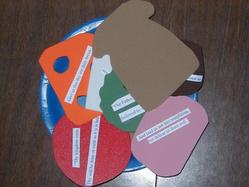 I made a “sandwich” out of different colors of Foamie Sheets. I did get creative and cut holes in the “cheese” and drew seeds on the “tomato”.
I made a “sandwich” out of different colors of Foamie Sheets. I did get creative and cut holes in the “cheese” and drew seeds on the “tomato”.
(Click on the photo to see a larger image.)
I glued words on each part of the sandwich ingredients as listed below. One side of each piece had the words of the Lord’s Prayer. Other side had interpretations.
The kids put the sandwich together in the correct order. We then talked about how prayer has different ingredients.
Instructions on sandwich construction:
- Cut two pieces of “bread” from brown Foamie sheets
- 1 piece of lettuce from green:
“Our Father, who art in heaven, hallowed be thy name.”
You are holy God. We call you Father because you love us like a father. - 1 piece of tomato from red:
“Thy kingdom come. Thy will be done on earth as it is in heaven.
May what you want God, be done here in our daily lives. - 1 piece of cheese from yellow:
Give us this day our daily bread.
We trust you God to give us each day the food and other things we need to live. - 1 piece of chicken from tan:
And forgive us our trespasses, as we forgive those who trespass against us.
Forgive us and help us to forgive others. - Another piece of lettuce from green:
And lead us not into temptation, but deliver us from evil.
Do not let anything cause us to do wrong. Keep us safe from our own weaknesses and poor choices. - 1 piece of white, mayo:
For thine is the kingdom and the power and the glory forever. Amen.
God is in control.
Resources:
- “The History of the Pretzel” https://www.history.com/news/t...el-a-twisted-history
- www.childrensermons.com/sermons/prayer.htm (prayer sandwich)
A lesson written by Carol Hulbert from First United Methodist Church, Ann Arbor, MI


